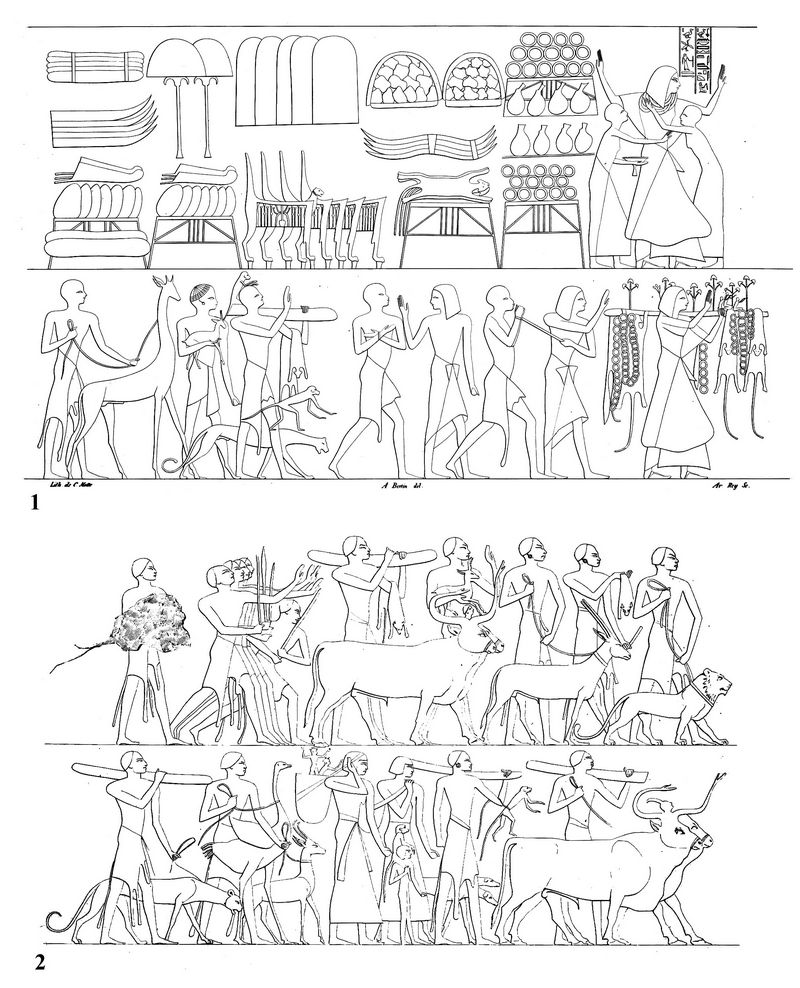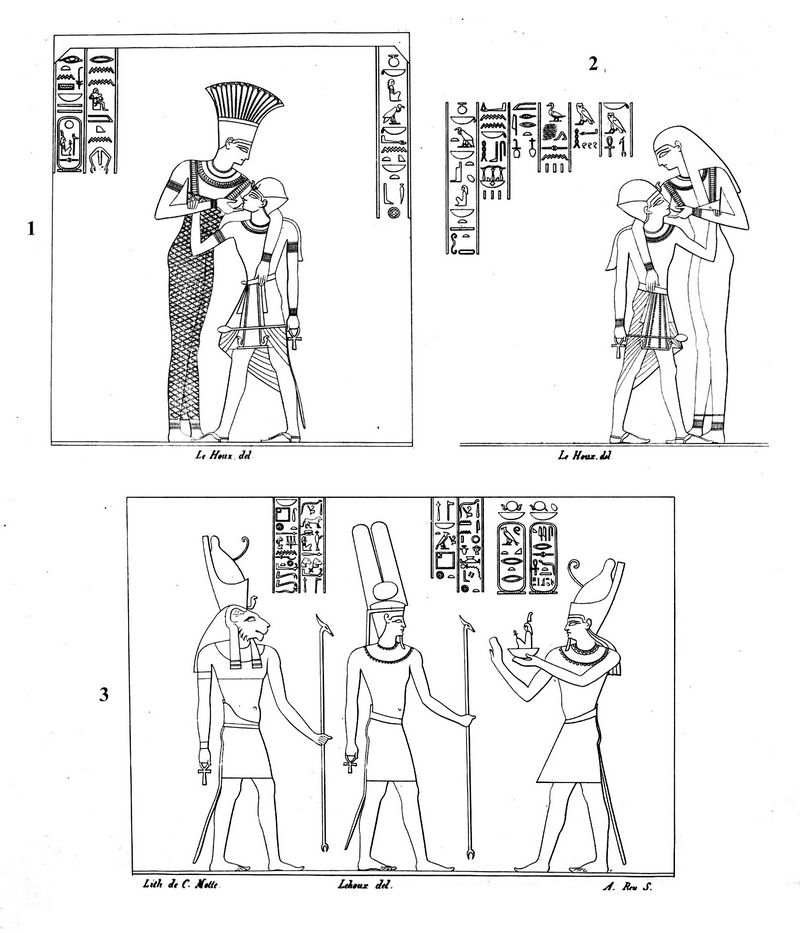| Southport : Original Sources in Exploration | | |
Letters Written from Egypt and Nubia, 1828-1829 Jean-Francois Champollion | | | | |
|
Eleventh Letter, part 3 (Jan. 28-Feb.1, 1829).
Near
Kalabschi is the interesting monument of Bet-Oulli, which took us the
days of January 28, 29, 30 and 31 until midday. There, my eyes were
consoled from the barbaric sculptures of the temple of Kalabschi, which
were made rich because we no longer knew how to make them beautiful, by
contemplating the historical bas-reliefs which decorate this temple (spéos),
in a very beautiful style, and of which we have complete copies. These
paintings relate to the campaigns against the Arabs and African
peoples, the Kouschi (the Ethiopians), and the Schari, who are probably
the Bischari of today; campaigns of Sesostris in his youth and during
the lifetime of his father, as Diodorus of Sicily expressly says, who
at that time made him submit, in fact, the Arabs and almost all of
Libya.
Fig. 17: Plate 62: Temple of Ammon at Beit-el-Wali; first panel on the right.
King
Rhamses, father of Sesostris, is seated on his throne in a naos, and
his son, dressed as a prince, presents him with a group of Asian Arab
prisoners (fig.17). Further on, the Pharaoh is represented as the victor,
(p.131) himself striking a man of this nation (fig.19), at the same time as the
prince (Sesostris) presents to him the military leaders and a crowd of
prisoners. The king, in his chariot, pursues the Arabs (fig.18), and his son
strikes with his ax the gates of a besieged city; the king tramples
underfoot the defeated Arabs, a long file of whom is brought to him as
captives by the prince his son: such are the historical paintings
decorating the left wall of what formed the main room of the monument,
assuming that this portion of the spéos has ever been covered.
Fig.18: Plate 64 (above): Temple of Ammon at Beit-el-Wali; third panel on the right.
Fig. 19: Plate 73 (below, right) Temple of Ammon at Beit-el-Wali; left side of entrance.
The
right wall presents details of the campaign against the Ethiopians, the
Bischari and the Negroes. In the first painting, of great extent, we
see the Barbarians in complete rout, taking refuge in their forests, on
the mountains, or in swamps; the second painting, which covers the rest
of this wall, represents the king seated in a naos and welcoming, with
a gesture of the hand, his eldest son (Sesostris), who presents to him,
1) an Ethiopian prince named Amenemoph, son of Poeri, supported
by two of his children, one of whom offers him a cup, as if to give
him the strength to arrive at the foot of the throne of the father of
his conqueror (fig.20-1); 2) Egyptian military leaders; 3) tables and sideboards
covered with gold chains and with them panther skins; bags containing
powdered gold; ebony trunks; elephant teeth; ostrich feathers; bundles
of bows and arrows; precious furniture; and all kinds of booty taken
from the enemy or imposed by (p.132) conquest; 4) following these
riches, some Bischari prisoners walk, men and women, one of them
carrying two children on her shoulders and in a kind of basket; follow
individuals leading to the king of living animals, the most curious of
the interior of Africa, the lion, the panthers, the ostrich, monkeys
and the giraffe, perfectly drawn, etc. (fig.20-2). We will recognize there, I
hope, the campaign of Sesostris against the Ethiopians, whom he forced,
according to Diodorus of Sicily again, to pay to Egypt an annual
tribute in gold, ebony and elephant teeth.

Fig.20: Plates 69 and 70: 1) Plate 69, Bet el Wali, temple, second panel at left. 2) Plate 70, Beit-el-Wali, temple, panel at left.
The
other temple sculptures are all religious. This monument was dedicated
to the great god Ammon-Ra and his secondary form Chnouphis. The first
of these gods declares several times, in his legends, to have given all
the seas and all the existing lands to his beloved son “the Lord of the
world (Sun guardian of justice) Rhamses (II). In the sanctuary, this
Pharaoh is represented sucking the milk of the goddesses Anouké and
Isis (fig.21). (I who am your mother, the lady of Elephantine,
said the first, I receive you on my knees, and present you with my
breast so that you can take your nourishment, O Rhamse)) “And I, your
mother Isis, said the other, I, the lady of Nubia, grant you the
periods of panegyries (those of thirty years) which you suck with my
milk, and which will flow into a pure life. " .

[Description pl.61 in Monuments of Egypt and Nubia by J-F Champollion (1835):
"1.
King Rhamses II, elder brother of Sesostris, child and helmeted, is
breastfed by the goddess Anouké. Both inscriptions contain the names of
the two characters.
2. The same king is nursed by the goddess Isis,
who is not characterized by any symbol; her name is found in
hieroglyphic inscriptions.
These two subjects are taken from the temple of Beit-Ouali, in Nubia,
3.
Emperor Tiberius offers a figure of Thmei to the god Ammon and another
lion-headed deity. (Taken from the temple of Déboud.)"]
I
had these two paintings copied, as well as several others, including
two bas-reliefs showing the Pharaoh victorious over the peoples of the
South and the (p.133) peoples of the North. We must not forget that the
Egyptians called the Syrians, Assyrians, Ionians and Greeks northern
peoples. I said goodbye to this monument of Bet-Oulli with some
difficulty because it was the last of the belle époque and of good
sculpture that I had to encounter between Kalabschi and Thebes.
Fig.22: Temple at Tafah. 1) from an 1838 lithograph by David Roberts. 2) from a 1911 photograph by Roeder, viewed from the southwest.
On
the 31st, at sunset, we were at Kardassi or Kortha, where I went to
visit the remains of a small temple of Isis, devoid of sculpture, with
the exception of a bas-relief on a column shaft. I had seen, two hours
before, the temples of Tafah (the ancient Taphis), also without
sculptures or hieroglyphic inscriptions; but we can easily judge, from
their type of architecture, that they belong to the time of Roman
domination.
Fig.23:
Temple at Kertassi, showing capitals at right with relief heads of the
goddess Hathor; from an 1838 lithograph by David Roberts.
On
February 1, we saw a boat coming towards us with an Austrian flag: this
was news for us, and it was a matter of conjecture; however, the boat
was also moving towards us, and I recognized on the bow Mr. Acerbi,
consul general of Austria in Egypt, who called me and greeted me with
his hand. We stopped our boats and spent a few hours talking about our
work with this excellent man, a distinguished publicist and writer, who
had treated us in such a kind manner during our stay in Alexandria. We
separated, he to go up to the second cataract, and I to return to
Egypt, with a promise to join us in Thebes, which is the Paris of Egypt
and the meeting place of the travelers, with all due respect to the big
city of Kairo and sad Alexandria.
Around
two o'clock in the afternoon, we were at Deboud or Déboudé: having gone
to the temple, passing under the three small propylons without
sculpture, I found that it had been built, in large part, by an
Ethiopian king named Atharramon ., and who must be the predecessor or
immediate successor of the Ergamenes of Dakké. The temple, dedicated to
Ammon-Ra, lord of Tebot (Déboud), and to Hathôr, and subsidiarily to
Osiris and Isis, was continued, but not completed, under the emperors
Augustus and Tiberius. In the sanctuary, still unsculpted, lie the
remains of a bad monolith naos, in pink granite, from the time of the
Ptolemies.
Fig.24: Temple at Deboud, showing bas-reliefs by the entrance, from an 1842 lithograph by David Roberts.
Our work being finished, we returned to our boats, in a hurry
to leave and take advantage of the rest of the day to arrive at Philae,
thus return to Egypt, and say goodbye to poor Nubia, whose drought had
already tired all my companions. journey; moreover, by setting foot
again in Egypt, we could hope to eat bread a little more bearable than
the meager unleavened pancakes with which our chief baker treated us
daily, quite up to the standard of the Arab gargotier that we were
given. in Kairo like a cordon bleu cook.
It
was at nine o'clock in the evening that we finally reached Egyptian
land again, landing on the island of Philae, giving thanks to its
ancient deities Osiris, Isis and Horus, that famine had not devoured us
between the two. cataracts.
Footnotes:
[Continue to part 4 of Letter 11]
[Return to Table of Contents]
|
v |
| Southport main page Main
index of Athena Review
Copyright © 2023 Rust Family Foundation.
(All Rights Reserved). | | |
.
|